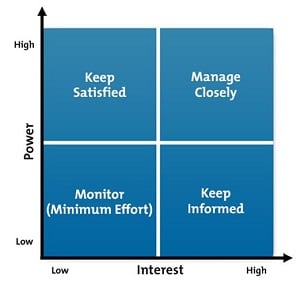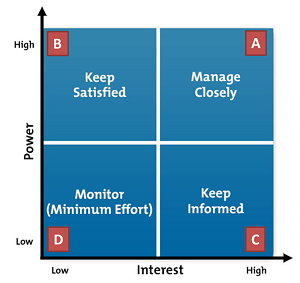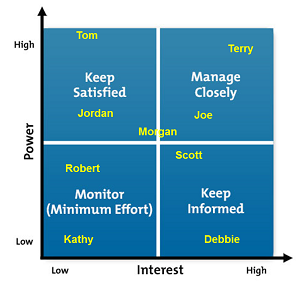Posted by Caveo Learning ● February 5, 2015
Tools for Easy and Efficient Stakeholder Management
 "One size fits all" is a misnomer. It’s not true with clothes, and it certainly isn’t true when it comes to stakeholder management.
"One size fits all" is a misnomer. It’s not true with clothes, and it certainly isn’t true when it comes to stakeholder management.
We know that stakeholders are crucial to the success of a learning project or initiative, whether they are learning leaders or reside in other areas of the organization. But not all stakeholders in the organization require the same levels of information and engagement.
Neglect the wrong ones and they might actively work against us. Manage the right ones well, and they will likely actively promote us and the project. But who are the “right” and “wrong” ones? How can we make sure everyone is satisfied in the manner with which we are “managing” them without having to create a separate plan for each person?
Start by using an easy tool called a Power/Interest Grid to categorize the project’s stakeholders. From there, it is easy to create a stakeholder management plan.
Who Are the Stakeholders?
First, let’s define stakeholder. Stakeholders are persons or groups who have an interest in an initiative. With basic audience analysis, we can break this down further into two groups:
- Those who have interest but not influence, meaning the change is being thrust upon them. These people are often referred to as targets.
- Those who have an interest but can often influence the change are stakeholders. This is likely a smaller group and, within organizations, it is often the leadership team, among others.
A first step is to identify the stakeholders. Depending on the initiative, and its size and importance, this listing can be job titles or it can be names. The higher up in the organization, the more likely these will be names versus titles, but when talking about large groups of employees, it will likely be titles. Let’s say we are looking at categorizing the senior leadership team within an organization so we know how best to engage them.
Now that we’ve identified the stakeholders, it’s time to pull out the Power/Interest Grid, a very easy yet efficient and effective way to prioritize communication and collaboration with a large group of individuals with disparate wants and interests. Based on discussions and agreement within the core team, we’re ready to start assigning individuals/groups to a square. Using this tool in PowerPoint makes it easy to move people from one category to another, as well as moving individuals within a particular box.
On the vertical axis, Power refers to how much power the person or group wields over the potential success of the project, as well as within the organization. On the horizontal axis, Interest refers to how invested the individual might be in this particular project. Let's examine the tool in more detail.
A person's position on the grid is a guide for engaging with them.
Now that stakeholder names or groups have been identified, it's time to assign them to a square. Recognize that this is a subjective ranking, so never share this list outside your core project team. However, among your core team, this ranking activity for categorizing stakeholders can generate a lot of discussion and ensure your team is aligned.
The Four Quadrants of a Power-Interest Grid
Box A: Manage Closely
These are high-power, high-interest individuals who are crucial to the success of the project. The most attention and communication efforts go here, as we want them to be closely managed. These are the people we must make the greatest efforts to satisfy with our stakeholder engagement efforts.
 Box B: Keep Satisfied
Box B: Keep Satisfied
These are high-power, low-interest individuals who just need to be kept in the know. They might not care as much about this particular corporate education project, but they are fairly influential within the organization. Keep these people adequately informed, but don’t over-communicate to the extent they become bored with the message.
Box C: Keep Informed
These are low-power, high-interest individuals who we want to engage due to their interest in the project. This is a good group to check in with to ensure no major issues are arising.
Box D: Monitor, Minimal Effort
These are low-power, low-interest individuals who can be monitored with minimal effort. Periodic communications are typically all this group really needs, if even that.
 At right is a sample of a Power-Interest Grid for a project that included a very senior group of individuals within an organization. Note that Terry was the learning solutions project sponsor and Tom was the CEO. Tom, although highly influential, wasn’t as interested in the project specifics, and he delegated to Terry accordingly.
At right is a sample of a Power-Interest Grid for a project that included a very senior group of individuals within an organization. Note that Terry was the learning solutions project sponsor and Tom was the CEO. Tom, although highly influential, wasn’t as interested in the project specifics, and he delegated to Terry accordingly.
(Again, never show the completed Power-Interest Grid to anyone. For instance, Kathy—shown in the lower left corner—might be very offended to learn that we felt she had low power and low interest.)
Once our Power-Interest Grid is completed, we're able to move forward with the strategic management process to create our customized stakeholder management plan. We really only need to have four different communcation and stakeholder engagement strategies for this group of individuals. This is much easier, more efficient, and more effective than having to list everyone and individually customize their messaging—or worse, to have to give everyone a one-size-fits-all approach.
Ready for the next steps in learning strategy development? Build a One Page Learning Plan. The One Page Plan is a collaborative and actionable document that helps ensure that stakeholders in all four quadrants of the Power/Interest Grid are aligned with learning KPIs and their corresponding business objectives.
Topics: Change Management, Managed Services

 Box B: Keep Satisfied
Box B: Keep Satisfied